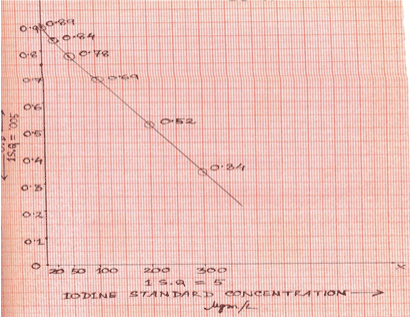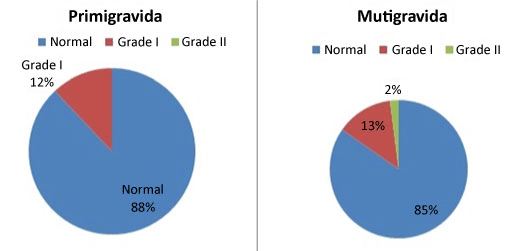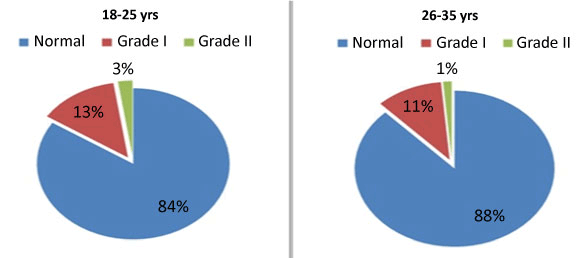Research Article Open Access
Iodine Status during Pregnancy among Tea Garden Workers in Assam and its Effect on the Foetus
| Dutta HK1* and Baruah M2 | |
| 1Associate Professor, Department of Pediatric Surgery, Assam Medical College and Hospital, Dibrugarh, India | |
| 2Assistant Professor, Department of Physiology, Assam Medical College and Hospital, Dibrugarh, Assam, India | |
| Corresponding Author : | Dutta HK Department of Pediatric Surgery Assam Medical College and Hospital Dibrugarh, Assam, India Tel: 91 9435031257 E-mail: hemontdut@gmail.com |
| Received August 13, 2014; Accepted September 09, 2014; Published September 15, 2014 | |
| Citation: Dutta HK, Baruah M (2014) Iodine Status during Pregnancy among Tea Garden Workers in Assam and its Effect on the Foetus. J Preg Child Health 1:110. doi: 10.4172/2376-127X.1000110 | |
| Copyright: © 2014 Dutta HK et al.This is an open-access article distributed under the terms of the Creative Commons Attribution License, which permits unrestricted use, distribution, and reproduction in any medium, provided the original author and source are credited. | |
Visit for more related articles at Journal of Pregnancy and Child Health
Abstract
Iodine deficiency during pregnancy causes wide spectrum of disorders in the fetus. Tea garden workers in Assam are known to have high prevalence of endemic goiter and congenital malformations. The present study is aimed to evaluate the iodine status of pregnant tea garden workers and its effect on the fetus. Urinary iodine (UI) level in casual urine samples was estimated in each trimester in 156 pregnant and 160 age-matched non-pregnant women from the same community. Although normal UI values were found in all pregnant women, significantly higher values were noted during the second trimester and among the older women. 12 babies were born preterm. Malformations were noted among 16 babies. 2 women in the control group received treatment for hypothyroid status. Normal UI recorded in the study may be because of universal consumption of iodized salt. Factors other than iodine may be responsible for the malformations noted in this study.
| Keywords |
| Iodine nutrition; Pregnancy; Congenital malformations |
| Introduction |
| Pregnancy affects virtually all aspects of thyroid hormone function. Lack of thyroid hormones result in amenorrhea, menorrhagia and infertility, frequent miscarriage, still births and congenital malformations. Assam falls in the sub-Himalayan endemic zone of iodine deficiency disorders (IDD). There was high prevalence of endemic goitre among the ethnic tea garden workers [1]. High prevalence of congenital malformations was also recorded in this community [2]. The present study is aimed at determining iodine nutritional status among pregnant tea garden workers and to examine any causal relationship between iodine status and fetal outcome. |
| Materials and Methods |
| The study was approved by the Institutional Ethical committee. As 90% of the ingested iodine is excreted in the urine, the benchmark method for determining the state of iodine nutrition has been the measurement of excretion of iodine in the urine. 156 pregnant women from tea garden community were included in the study spanning 2 years. Women who had missed abortion during the Ist or early 2nd trimester were excluded from the study. History obtained regarding food habit, type of salt consumed, source of drinking water and past obstetrical history. Clinical evaluation of women done to grade the goiter if present. Urine samples from 160 age-matched women were collected as controls. |
| Urinary iodine estimation: Urine is digested with ammonium persulphate. Iodide is the catalyst in the reduction of ceric ammonium sulphate [yellow] to cerous forms [colorless] and is detected by rate of colour disappearance [Sandell-Kolthoff reaction]. |
| 2 ce+++ + 2I+ → 2 ce++ + I2; 2 ce++ + I2 → 2 ce + 2 I+; 2 I+ + As3+ → I2 + As5+ |
| Collection of urine: Random urine sample of about 50 ml was collected in ‘iodine free’ plastic containers from each pregnant woman in all the trimesters. 2-3 drops of Toluene was added to prevent bacterial growth. Stock solutions (1 μg iodine/ml) with working standards of 20, 50, 100, 200 and 300 were prepared (Figure 1). A pooled urine sample was prepared for internal quality control assessment. The mean and standard deviation of this sample was calculated and analyzed with every batch of test samples. The 95% confidence interval (CI) was then calculated and used as the operating control range. A standard curve was constructed on a graph paper by plotting iodine concentration of each standard on the abscissa against its optical density on the ordinate (Levy Jenning plot). Student’s t-test was employed to analyze the observations. |
| Results |
| The source of drinking water of the studied population was hand pump and tap water. All women used iodinated salt. Mean and median UI values were within normal limits in all women. No significant difference of UI levels was noted between the primi and multigravida women and the younger and older women during the Ist and 3rd trimesters, however, significantly higher values of UI were noted during the second trimester and among the older women (26-35 years) (p< 0.05) (Table 1 and 2). The UI levels were also significantly higher in the test population than the control group (p<0.001) (Table 3). Goiter was recorded in 14.1% of the women, mostly among the multigravida and younger women (Figures 2 and 3). One baby was stillborn. 12 babies were born preterm. Malformations were noted in 16 babies. Co-morbid conditions other than goiter were noted among 11 women (Table 4). In the control group 2 women had low UI and high TSH values requiring treatment. |
| Discussion |
| Iodine deficiency is one of the major nutritional public health problems affecting over 800 million people in 118 countries including India [3]. More than 400 million people in Asia alone suffer from severe iodine deficiency [4]. According to our estimation, 167 million people are at risk of iodine deficiency disorders (IDD) in India including 54 million with Goiter, 2.2 million with cretinism and 6.6 million with mild neurological deficits [5]. In India, the classical belt of IDD includes the north eastern states of Assam, Arunachal Pradesh, Mizoram, Nagaland and Manipur and West Bengal, part of Bihar, Uttar Pradesh, Himachal Pradesh, Haryana, Punjab and Jammu and Kashmir [1]. No state in India is believed to be free from IDD. |
| The ICMR Task Force study carried out during 1983-1986 observed that goiter prevalence in Dibrugarh district where the present study was conducted was 65.8% [1]. Another interesting observation in this study was higher prevalence of endemic goitre among the tribal population and the tea estate workers as compared to the non-tribal population. Prevalence of goiter was also found to be higher among rice eating population and among people who used surface water for drinking. However, study on iodine nutrition of pregnant mothers, which is one of the most vulnerable group for iodine deficiency has not been done in this part of the country. Deficiency of iodine and other micronutrients in pregnant women can result in frequent miscarriage, still births, decreased fertility and a higher incidence of congenital abnormalities in the foetus [6]. Insufficient iodine supply to the foetus can result in reduced birth weight and reduced resistance endangering the very survival of the child. One earlier study carried out among the tea garden workers in Assam found high prevalence of congenital malformations [2]. |
| The present study shows that prevalence of iodine deficiency has decreased significantly among the people who had high prevalence of deficiency few decades back. This may be because of universal use of iodized salt. Currently, 68% of households from areas of the world with previous iodine deficiency have access to iodized salt [7]. A study on 35,223 school children in 28 countries has shown that many previously iodine deficient parts of the world now have median urinary iodine concentrations well above 300 μ g/L, which is excessive and carries the risk of adverse health consequences [7]. It is now believed that iodized salt is not the ideal means to deliver iodine in pregnant women, bbecause of the need to limit salt intake during this period. Glinnoer proposed that administration of iodine containing multivitamin tablets to pregnant and lactating women could meet the daily requirement of 250 μg iodine [8]. A study from Papua, New Guinea observed that injection of iodized oil given prior to pregnancy would prevent the occurrence of the neurological syndrome of endemic cretinism in the infant [9]. It was observed that early effects of iodine deficiency on the foetus are mediated by reduced transfer of maternal T4 before the onset of foetal thyroid function. |
| One study on iodine nutritional status of pregnant women during nd and 3rd trimesters in a rural Indian population found that maternal UIC had limited influence on offspring developmental outcomes [10]. Another study suggested that determining an individual pregnant woman as iodine deficient is problematic for cross-sectional studies examining associations between iodine status in pregnancy and developmental outcomes in the child [11]. |
| The present study found high prevalence (10.3%) of congenital malformations among the studied population. However, only 3 patients (1.9%) had major malformations, which is comparable to normal population. All women in the study group including the mothers of the stillborn and babies with malformations had normal UIC values. Comorbid conditions, other than goiter, were noted in 11 mothers. These conditions did not seem to have any influence on iodine nutritional status of the mothers or on fetal health. |
| Conclusion: Normal UI recorded in the study may be because of universal consumption of iodized salt. Presence of goiter in 22 women suggests iodine deficiency in the past or may be caused by goitrogenic food. Factors other than iodine deficiency may be responsible for higher incidence of CMs noted in this study. |
References
- Indian Council of Medical Research (1989) Epidemiological survey of endemic goiter and endemic cretinism: Report of ICMR Task Force Study. New Delhi: Indian Council of Medical Research.
- Dutta HK, Bhattacharyya NC, Sarma JN, Giriraj K (2010) Congenital malformations in Assam. J Indian AssocPediatrSurg 15: 53-55.
- Khubchandni RP, Sainani GS (1988) Iodine Deficiency. Journal Applied Med 14: 645-646.
- Hetzel BS (1983) Iodine deficiency disorders (IDD) and their eradication. Lancet 2: 1126-1129.
- Sheela V (1994) Control of iodine deficiency- The National Programme, Current status. NFI Bulletin 5: 1-4.
- Hetzel BS, Mano MT (1989) A review of experimental studies of iodine deficiency during fetal development. J Nutr 119: 145-151.
- Delange F, de Benoist B, Pretell E, Dunn JT (2001) Iodine deficiency in the world: where do we stand at the turn of the century? Thyroid 11: 437-447.
- Glinoer D (2007) The importance of iodine nutrition during pregnancy. Public Health Nutr 10: 1542-1546.
- Buttfield IH, Hetzel BS (1967) Endemic goitre in eastern New Guinea, with special reference to the use of iodized oil in prophylaxis and treatment. Bull World Health Organ 36: 243-262.
- Lean MI, Lean ME, Yajnik CS, Bhat DS, Joshi SM, et al. (2014) Iodine status during pregnancy in India and related neonatal and infant outcomes. Public Health Nutr 17: 1353-1362.
- Skeaff SA (2012) Assessing iodine intakes in pregnancy and strategies for improvement. J Trace Elem Med Biol 26: 141-144.
Tables and Figures at a glance
| Table 1 | Table 2 | Table 3 | Table 4 |
Figures at a glance
 |
 |
 |
| Figure 1 | Figure 2 | Figure 3 |
Relevant Topics
Recommended Journals
Article Tools
Article Usage
- Total views: 14706
- [From(publication date):
November-2014 - Aug 31, 2025] - Breakdown by view type
- HTML page views : 10063
- PDF downloads : 4643
